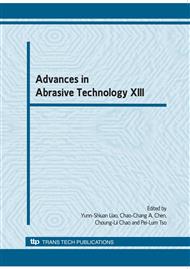p.429
p.435
p.441
p.447
p.457
p.463
p.469
p.475
p.481
Processing Characteristics of Structured Lapping Films under Grinding Load Control
Abstract:
Pyramidal structured lapping film, which has minute pyramidal structures formed by abrasive grains and adhesives on polyester films, is newly developed finishing tool[1,2]. It is said that the tool has eminent grinding characteristics, mainly, good finished surface quality because chips generated during grinding process can escape into spaces between pyramidal structures, and high grinding efficiency because new abrasive grains come out from inside of the pyramidal structures during grinding process. However, finishing characteristics of this grinding tool have not yet been fully explained. In this research, the grinding experiments were conducted, focusing on the efficiency of grinding. The grinding forces were measured to examine the state of the surface of the tool. In addition, to improve the grinding efficiency using this tool, a method for changing the grinding load continuously while processing was used. This method was intended to enhance the effective chip generation and new abrasive grain emergence. As a result, stock removal of the workpiece was increased more than when the grinding load was kept constant. Moreover, using scanning electron microscope, this new grinding tool surface was observed, and its effectiveness was examined.
Info:
Periodical:
Pages:
457-462
Citation:
Online since:
August 2010
Authors:
Price:
Сopyright:
© 2010 Trans Tech Publications Ltd. All Rights Reserved
Share:
Citation:


